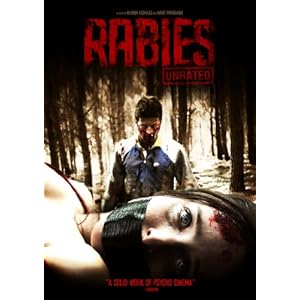Israel’s first horror – and not their last 
Different people all victims of circumstance and bad timing
Apparently, Israel’s first horror, RABIES (“Kalevet” is the Hebrew title) was such a success in its native land that more are on the way.
As for this venture, the writer/director team of Aharon Keshales and Navot Papushado certainly captured an element of suspense and tension, as well as idiosyncratic dialogue, sadly lost in many horrors that focus more on visuals (aka gore) instead of a good story. However, this does not mean the tale was flawless.
This low budget story is comprised of several different groups of characters that due to circumstance, become intertwined with each other, which proves not to be a good thing by any means.
An ensemble film, we follow the characters as they work their way in and out of trouble, and in and out of a forest. Not an easy task when entrapment, kidnapping, murder, sexual abuse, assault, maiming and more are on the menu. Why is it called RABIES? That is one of the movies many mysteries, however, I have seen references that state kalevet also means rage. Although that may fit the movie better, Keshales and Papushado may have had another idea. In the movie, most of the characters are non-violent yet turn to violence when, once again, circumstance dictates otherwise. The directorial team may have focused on RABIES because of the notion that violence begets violence. If one is bitten by a rabid animal and bites another, the virus spreads exponentially. This is the case here, but this is also where the duo trip themselves up.
For the bulk of the film, we are in an area with our core group of characters, but late in the third act, as the story and violence reaches its zenith, one character escapes this isolated area and makes it home, while another tries to hitch a ride with a family. It may have served the movie best to have all the characters remain in that “infected” region of forest. Granted, we can suppose the characters that freed themselves will spread the “disease” elsewhere, but this is never implied.
A couple of other problems involve the police (Lior Ashkenasi and Danny Geva). As we often see in movies of this ilk, one cop is a major handful and a half-a-frequency off, and the other is far too easygoing to prevent his partner from becoming batshit crazy. Those two characters were the most stock of the bunch with Mikey (Ran Danker) and Pini (Ofer Shecter), as the clean-cut college boys, coming in a close second.
As for the acting, it was first-rate and no one missed a beat. The standouts were Ashkenasi as off-the-rails Danny the cop, Geva as his hesitant partner, spunky and independent Ania Bukstein as Adi, Yael Grobglas as Shir and Menashe Noy as Menashe. This does not mean any of the other actors faltered, but the aforementioned had that extra-special something. Hopefully, we’ll see more of them in the future. Some in the American market may see that as a bit farfetched, but Israel has also given us the exhilarating Natalie Portman, Chaim Topol of FIDDLER ON THE ROOF fame (both stage and screen), and Daliah Lavi, known by most horror fans as Nevenka in cult favorite THE WHIP AND THE BODY (Italy/France, 1963).
Visual effects and make-up were solid for the most part, and Guy Raz’s photography was wonderful – and this was his first film. To further enhance the technical aspects of the movie, Keshales and Papushado took to editing as well and did a masterful job, though they have one too many fadeouts.
If you like grit and suspense with solid characters, a bit of gore and some sex appeal, this will certainly fit the bill.
It’s a shame the story didn’t remain self-contained, or that we didn’t witness the violence spilling over beyond the forest like the spread of rabies, but this movie is certainly worth a look.
3 out of 5 stars
